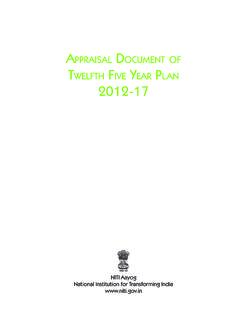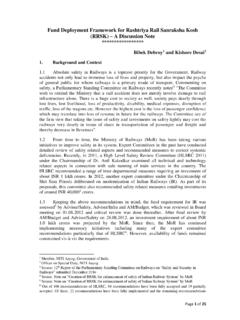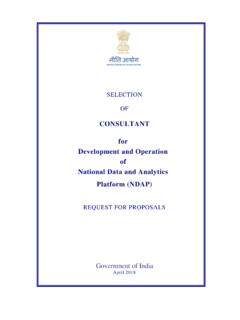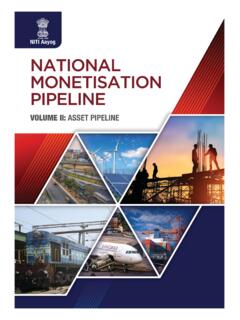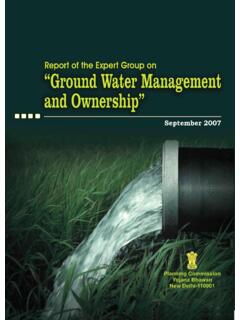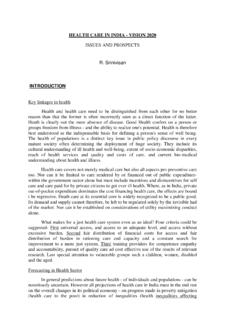Transcription of Draft National Energy Policy - NITI Aayog
1 Draft National Energy Policy NITI Aayog , Government of India Version as on 0. NEP: Version as on CONTENTS. Chapter 1 Preamble Page 1. Chapter 2 Objectives Page 4. Chapter 3 Energy Demand Page 10. Box 1 Rural Electrification Page 17. Box 2 Clean Cooking Access Page 19. Box 3 Grid Integration of Renewable Energy Page 23. Energy Supply Fossil Fuel Based Energy Sources Chapter 4 Oil and Gas Page 27. Chapter 5 Coal Page 34. Non Fossil Fuel Based Energy Sources Chapter 6 Renewables Page 41. Chapter 7 Nuclear Page 47. Chapter 8 Electricity Page 51. Facilitating Mechanisms Chapter 9 Regulators Page 60. Chapter 10 Infrastructure Page 64. Chapter 11 Human Resource Development Page 68. Chapter 12 Technology and Research & Development Page 72. Chapter 13 Overseas Engagements Page 76. Chapter 14 Air Quality Page 80. Chapter 15 India Vision 2040 Page 85.
2 Annex NITI Ambition Scenario 2040 Page 90. 1. List of Tables: Table 1 Energy Demand Table 2 Renewable Energy Integration and Efficient Grid Operation Strategies Table 3 Domestic Production of different Fuels in India Table 4 Energy Demand Table 5 Segregation of Energy Demand by Fuel Table 6 Electricity Demand Table 7 Share of Electricity in Energy Demand Table 8 Demand for different Hydrocarbons Table 9 Domestic Production of Hydrocarbons Table 10 Electricity Capacity Table 11 Primary Energy Supply Table 12 Electricity Generation Table 13 Conversion Factors List of Figures: Figure 1 Trend of Domestic Coal Production in India Figure 2 GDP Trajectory a NEP: Version as on List of Abbreviations AC Air Conditioners ACS Average Cost of Supply AD Accelerated Depreciation BAU Business As Usual BCM Billion Cubic Metres BEE Bureau of Energy Efficiency CAGR Compounded Annual Growth Rate CBET Cross Border Electricity Trade CBM Coal Bed Methane CCS Carbon Capture and Storage CEA Central Electricity Authority CGD City Gas Distribution CIL Coal India Limited CMPDI Central Mine Planning and Design Institute CO2 Carbon Dioxide CSP Concentrated Solar Power CTL Coal to Liquid CTO Chief Technical Officer DBT Direct Benefit Transfer DBT-L Direct Benefit Transfer Liquefied Petroleum Gas DDG Decentralized Distributed Generation DDUGJY Deen Dayal Upadhyaya Grameen Jyoti Yojana DELP Domestic Efficient Lighting Programme DME Dimethyl Ether DSR Demand Side Reduction DST Department of Science and Technology E&P
3 Exploration and Production EESL Energy Efficiency Services Limited ESCO Energy Service Company EV Electric Vehicles FBR Fast Breeder Reactor b NEP: Version as on FSA Fuel Supply Agreement GAIL Gas Authority of India Limited GDP Gross Domestic Product GHG Greenhouse Gas GSI Geological Survey of India HDI Human Development Index HDV Heavy Duty Vehicle HELE High Efficiency Low Emission HRD Human Resource Development IAEA International Atomic Energy Agency IBM Indian Bureau of Mines IEA International Energy Agency IESS India Energy Security Scenarios IGCC Integrated Gas Combined Cycle IREDA Indian Renewable Energy Development Agency Limited Kgoe Kilogram of Oil Equivalent kWh Kilo Watt Hours LCOE Levelized Cost of Electricity LDV Light Duty Vehicle LED Light Emitting Diode LNG Liquefied Natural Gas LPG Liquefied Petroleum Gas LWR Light Water Reactor Mboe Million Barrel of Oil Equivalent MDO Mine Developer cum Operator MoEF&CC Ministry of Environment.
4 Forests and Climate Change MoPNG Ministry of Petroleum and Natural Gas MoSPI Ministry of Statistics and Program Implementation Mtce Million Tons of Coal Equivalent Mtoe Million Tons of Oil Equivalent MW Mega Watts NAPCC National Action Plan on Climate Change NDCs Nationally Determining Contributions c NEP: Version as on NELP New Exploration Licensing Policy NEP National Energy Policy NGO Non-Governmental Organization NISE National Institute of Solar Energy NIWE National Institute of Wind Energy NMCC National Mission on Clean Cooking NMEEE National Mission on Enhanced Energy Agency NMT Non-motorized transport NOC National Oil Company NPCIL Nuclear Power Corporation of Indian Ltd. NRDC National Research Development Corporation NSS National Sample Survey NTPC National Thermal Power Corporation OALP Open Acreage Licensing Policy OECD Organization for Economic Cooperation and Development OIDB Oil Industry Development Board OMC Oil Marketing Companies ONGC Oil and Natural Gas Corporation PAT Perform, Achieve and Trade PCRA Petroleum Conservation Research Association PGCIL Power Grid Corporation of India PHWR Pressurized Heavy Water Reactor PLF Plant Load Factor PMUY Prime Minister Ujjwala Yojana PNG Piped Natural Gas PNGRB Petroleum and Natural Gas Regulatory Board PPA Power Purchase Agreements PPP Public Private Partnership PSU Public Sector Undertaking PWD Public Works Department R&D Research and Development R&R Resettlement & Rehabilitation RE Renewable Energy d NEP.
5 Version as on RESCO Renewable Energy Service Company RPO Renewable Purchase Obligation SAARC South Asian Association for Regional Cooperation SDA State Nodal Agency SECI Solar Energy Corporation of India SERC State Electricity Regulatory Commission SUVs Sport Utility Vehicles T&D Transmission and Distribution TEC Telecommunication Engineering Centre TWh Terwatt Hour UDAY Ujwal Discom Assurance Yojana ULB Urban Local Bodies UMPP Ultra Mega Power Project UNFCCC United Nations Framework Convention on Climate Change US United States of America VGF Viability Gap Funding e NEP: Version as on Chapter 1. Preamble Energy is acknowledged as a key input towards raising the standard of living of citizens of any country, as is evident from the correlation between per capita electricity (a proxy for all Energy forms) consumption and Human Development Index (HDI).
6 Accordingly, Energy policies of India have over the years directly aimed to raise per capita Energy (and electricity) consumption, even while the main focus of the country's development agenda has been on eradication of poverty. With nearly 304 million Indians without access to electricity, and about 500 million people, still dependent on solid bio-mass for cooking, it may be acknowledged that the country has to still go a long way on securing its Energy security objective. While India strives to achieve a double digit growth rate in its National income, making clean Energy available to all of its citizens, ought to be included as a key component of the poverty alleviation programmes. The National Energy Policy (NEP) aims to chart the way forward to meet the Government's recent bold announcements in the Energy domain. All the Census villages are planned to be electrified by 2018, and universal electrification is to be achieved, with 24x7 electricity by 2022.
7 The share of manufacturing in our GDP is to go up to 25% from the present level of 16%, while the Ministry of Petroleum is targeting reduction of oil imports by 10% from 2014-15 levels, both by 2022. Our NDCs target at reduction of emissions intensity by 33%-35% by 2030 over 2005, achieving a 175 GW renewable Energy capacity by 2022, and share of non-fossil fuel based capacity in the electricity mix is aimed at above 40% by 2030. In view of the fact, that Energy is handled by different Ministries that have the primary responsibility of setting their own sectoral agenda, an omnibus Policy is required to achieve the goal of Energy security through coordination between these sources. This is also expected to mainstream emerging Energy technologies, and provide consumer Energy choices. The NEP builds on the achievements of the earlier omnibus Energy Policy the Integrated Energy Policy (IEP), and sets the new agenda consistent with the redefined role of emerging developments in the Energy world.
8 A number of far-reaching developments have taken place in the local and global Energy space which have to be reflected in our own Policy framework. There is a need to support the trends which usher in efficiency by a pro-active Policy . While steps have already been taken by the Government to embed many such developments in the sectoral Energy policies, however, it is desirable to develop a clear roadmap so that there is clarity amongst all the stakeholders on the Government's long-term Energy agenda. Long term investors, both on supply and demand sides, need clarity on stable Energy Policy outlook. The following global developments call for Policy clarity: 1. NEP: Version as on Changes in the Energy mix The world is moving away from overwhelming dependence on fossil fuel, and within the fossil fuels, away from coal and oil in favour of gas.
9 Against an 88%. total share of fossil fuels globally in the primary Energy mix in the year 2005, the same fell to 86% in the year 2015. The share of oil has in particular fallen from 36% to 33%, while that of natural gas has increased from 23% to 24%, and that of Renewable Energy (including nuclear and large hydro) has gone up from to14% in the period 2005-15. The above trends, principally owing to climate change concerns, are expected to be maintained over the medium term. Abundance in supply of natural gas The success of horizontal drilling combined with the technology of hydraulic fracture, has come to be established in the US where the production of natural gas went up from 511 BCM in 2005 to 767 BCM in 2015. This has boosted the already rising production of natural gas in the world from 2791 BCM in 2005 to 3539 BCM in the year 2015. As the price of gas is lower than that of oil, and is also one-third lesser as carbon emitting than oil, the ascendency of gas vis-a-vis oil is likely to continue in the near foreseeable future.
10 Over supplied oil and gas markets Due to multiple reasons including the two factors listed above, along with other commodity prices, oil and gas prices have softened, and this is triggering Energy Policy reforms across the world. The prices of oil and gas have fallen by 50%. and 70%, respectively over 2014. Many oil importing countries including India have been able to attempt bold petroleum pricing reforms, and are in a sound fiscal position to attempt larger Energy Policy reforms. Maturity of renewable Energy technologies The sharp decline in the prices of wind and solar technologies in the recent years by about 60% and 52% respectively between 2010 and 2015 (in kWh terms), has led to a change in the relative importance of Energy sources. Tropical countries, including India, are richly endowed with the above resources, and can harness them in an innovative manner to meet Energy requirements at decentralised locations.
